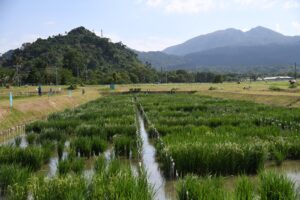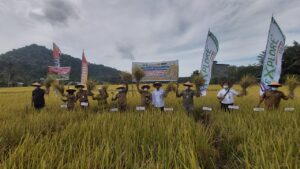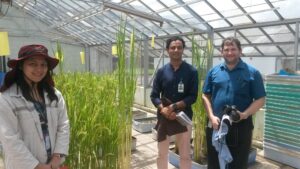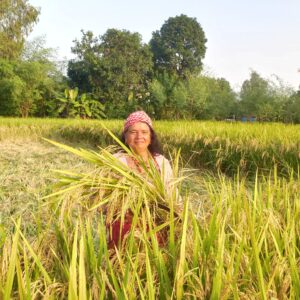Rice production in Africa In sub-Saharan Africa, rice is a very important staple and cash crop. In 2006, the region produced more than 21.6 million metric tons of rice and imported 9.4 million tons. African imports accounted for more than one-third of the internationally traded rice, which cost approximately US$2 billion in foreign exchange. Over the past 3 years, local rice prices have increased sharply. In Mozambique, during 2008, rice imported from Asia sold for $930 per ton in local stores and markets, which was nearly three times the price in 2007. Even today, in many villages and rural markets, polished rice continues to sell for $0.80– 0.90 per kilogram, or $800–900 per ton.
Many African governments now realize that relying on the world market to supply their rice is very risky and expensive, and many consider this an unwise long-term strategy. To avoid severe food insecurity and, in some countries, civil instability, governments are now serious about increasing rice production.
The International Rice Research Institute (IRRI) and the Africa Rice Center (AfricaRice) are working closely with many sub-Saharan governments, non-government organizations, and commercial companies to increase rice production across the region.
The potential to increase production
Rice productivity in East and southern Africa is now very low, with yields averaging between 1 and 1.5 tons per hectare. If this region can maximize its fertile lands and acquire ready access to water and other inputs such as fertilizer, Africa can double or even triple its rice production.
Production constraints
At present, however, rice farmers face constraints that constitute a combination of inappropriate and poor management skills, timing of operations, and availability of labor at critical times. These factors are often interrelated and, in many cases, controlled by factors from outside the farm.
Diseases such as HIV/AIDS and tuberculosis, plus the migration of young people to the mines and other urban industries, have reduced the local farm labor pool. When labor is available, productivity is often very low because of poor health and nutrition problems.
Moreover, in many areas, rice crops are not planted on time and yield losses of up to 2 tons per hectare have been recorded on the same farm with plantings 1 month apart. To compensate for this, farmers either plant more seeds or transplant older seedlings. Unleveled and uneven fields also result in higher water requirements, more weeds, poor fertilizer efficiency, and nonuniform crop ripening.
Uneven ripening of crops causes delays in harvest and increases losses from shattering, birds, and weather damage. Late-planted crops are also much more susceptible to pest damage, especially leaf diseases. Delays during harvesting, threshing, and drying also cause losses in both grain quantity and quality.
Following the harvest stage, losses during postharvest are also very high, ranging from 15 to 50%. In some instances, all the grains are lost, contaminated by fungus, particularly mycotoxins, or spoiled by rain after harvest. Farmers lose much of their grain because of poor postharvest management, outdated postharvest technology, and poor and unhygienic storage facilities. Since most of the crop is hand-threshed, farmers prefer to harvest crops at lower moisture content—as this makes threshing easier. This often means that the crop is left in the field a month longer than what is necessary. The outcome is less grain and poorer rice quality that later translates into consumers turning away from locally produced rice, thereby reducing farmers’ income.
Moreover, potential income is lost as many farmers sell their grain at the point of harvest. If farmers could store their grain safely and have access to transportation—so they are not at the whim of local traders—they could increase the value of their grain by 20–30% within 2–3 months after harvest.
In these circumstances, if postharvest losses in sub-Saharan Africa were reduced by 50%, this would provide another 2 million tons of paddy or 1.6 million tons of milled rice. This is equivalent to nearly 30% of imports and the real value is $700 million per year.
Overcoming the problem
One way to overcome the timeliness problem and improve the efficiency of operations is to add more energy to the system.
Increasing labor is not really an option. But, small machines, such as 2-wheel tractors, grain threshers, and mechanical weeders, can be introduced to boost production.
Where mechanization has been introduced, farmers observed that timeliness of operations improved, as did the efficiency and quality of the end product. Land was much better prepared, weed growth declined, crops were harvested at higher moisture content, and grains were stored safely and much earlier. When 2-wheel tractors are combined with a trailer, many on-farm transportation and market isolation problems are solved. The engine can also be used as an auxiliary power source for pumping water, crop threshing, rice milling, and generating electricity. This combination of equipment helped pave the way for self-sufficiency in many Asian countries and it has the same potential in Africa. IRRI and the AfricaRice are building on the lessons learned in Asia and are now importing small-scale machines for testing and demonstration in Africa.
IRRI, specifically, is collaborating with the government, machinery manufacturers, and dealers in Tanzania and Mozambique to support the importation, fabrication, and field demonstration of equipment.
In 2008, IRRI introduced 2-wheel tractors, threshers (both engine- and pedal-driven), manual cone weeders, and drum seeders into Mozambique. Then, in 2009, another batch of threshers was shipped to Tanzania. A 2-wheel tractor and a pedal and engine-driven thresher are now on their way to Burundi under the IRRICARE project.
The pieces of equipment imported into Mozambique have already proved successful. Hence, the government is now ordering more 2-wheel tractors and threshers from Asia. A local machinery manufacturer has already built and tested the first engine-driven thresher. Cone weeders have also been built locally and a pedal thresher is on the way. The cone weeders proved to be six times faster than hand weeding when tested in southern Mozambique.
In Tanzania, 2-wheel tractors are starting to become very popular. More than 500 machines have been imported, with many going into the rice-growing areas. IRRI is working with the local importer and the Mechanization Section in the Ministry of Agriculture to further support the expansion of 2-wheel tractors and other equipment. Pedal threshers are already being manufactured in Tanzania and an engine-driven thresher will soon follow.
After initial tests, drum seeders are now being fabricated locally in Mozambique and will soon be in Tanzania. The imported plastic Asian version introduced for demonstrations has already succumbed to African rats and rough handling. A metal version is now being built.
Adoption
The adoption and sustainable use of equipment in Africa will take time. IRRI’s experience in Asia suggests that it would take 8–10 years for the mechanization program to fully develop—from initial testing to local ownership and wide-scale adoption. And, the key to a sustainable mechanization program is to base it on sound business principles from the beginning. The use of the equipment must show a strong financial benefit, have local ownership and dealer support, have a local champion, have government support, and provide training for all players.
The cost of hiring machinery contractors in Africa is now excessively high. Where large tractors are used, local contractors charge $70–80 per hectare for one pass, and rice millers charge $80–100 per ton for contract milling. In comparison, these costs are nearly three times those of their Asian counterparts. Labor costs in Africa range from $1 to $2 per day, as in Asia.
The cost of importing equipment to East and southern Africa is also very high. A tractor that costs $2,500 in Thailand costs more than $5,000 in Tanzania. One-off fabrication costs are also expensive, but, we hope, these will decline when larger numbers are manufactured locally and more dealers come into the market.
In spite of the high cost of imported equipment, there is a substantial economic benefit in using 2-wheel tractors for land preparation. One 2-wheel tractor can plow 1 hectare a day and uses approximately 20 liters of diesel. Add to this labor, repair, and maintenance, and the total operating cost is approximately $35 per hectare. Obviously, a cost of ownership must be added, so the overall cost will be approximately $50 per hectare. This compares economically very favorably with current manual and large-tractor plowing. Note that the tractor can also be used as a power source for threshing, pumping water, transportation, and generating electricity.
Cooperative ownership appears to be the obvious solution for purchasing equipment in the short term. Many African farmers are already used to working in associations or cooperatives, so this should not be a problem. Local credit organizations have started working with cooperatives and governments now see mechanization as the way forward.
When introducing machines, changes to current farming practices are often required. Several examples have already taken place in Mozambique. Traditional manual threshing requires straw to be left long, whereas mechanical threshing requires short straw. Similarly, the use of mechanical cone weeders requires seedlings to be sown in rows.
IRRI and the AfricaRice have a pivotal role in making mechanization happen. On-farm demonstrations, support for the private sector, and, most important, local training in the use and maintenance of equipment are already taking place. Like in Asia, this will be a long-term transition, but, it is a basic requirement for rice production to increase in Africa.
______________________________________
Joseph Rickman is a Senior Scientist with specialization in mechanization and production systems.










